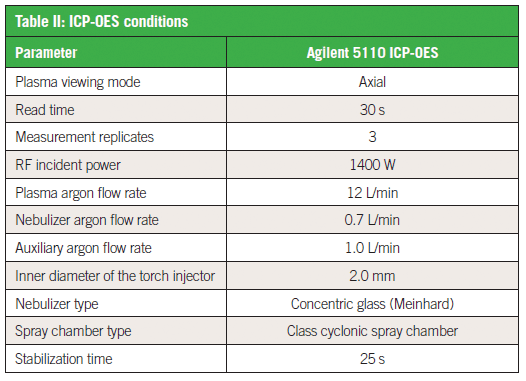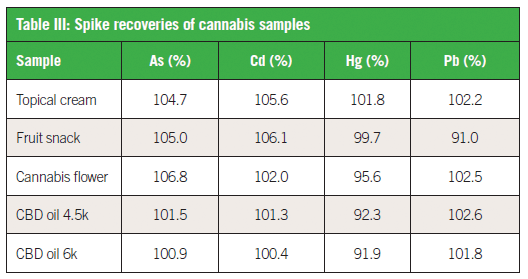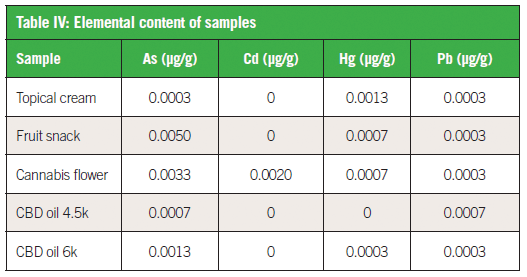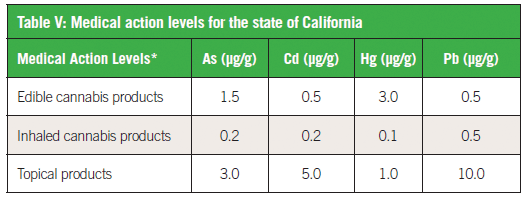Microwave Digestion and Trace Metals Analysis of Cannabis and Hemp Products
Spectroscopy
In 1970, marijuana was designated a Schedule 1 drug, under the Controlled Substances Act, making it nearly impossible for laboratories to perform cannabis research. However, medicinal use of cannabis is now legal in Canada and 33 U.S. states. With the passage of the Farm Bill in 2018, it is now federally legal to grow and process hemp in all 50 states. All of this interest in medical cannabis and cannabidiol (CBD) has highlighted the need for good analysis methodology in this relatively young market. Cannabis analysis is still developing standardized protocols, requirements, and acceptable testing practices. Typical testing requirements for cannabis and its products include analysis of heavy metal, pesticide residues, and the potency of active ingredients such as tetrahydrocannabinol (THC). The terpene content of cannabis is also important. Terpenes have been shown to have beneficial uses for treatment of conditions ranging from cancer and inflammation to anxiety and sleeplessness. It is believed that the combination of terpenes and cannabinoids in cannabis produce a synergistic effect with regards to medical benefits.
Certain heavy metals can cause adverse effects on human health. Toxic heavy metals such as arsenic, cadmium, lead, and mercury are persistent once released into the environment and can accumulate in cannabis plants. Since hemp is a strain of cannabis that contains very little THC, it is susceptible to bioaccumulation of heavy metals like its THC-containing relative. Cannabis-based products such as foods, oils, tinctures, and salves should be tested for the presence of heavy metals to ensure patient safety and product quality. Cannabis and CBD-infused products have grown in popularity in states that allow recreational use of cannabis and hemp. This application note details the digestion and analysis of various forms of hemp and cannabis products.
Instrumentation
A CEM MARS™ 6 microwave digestion system was used to digest the varied cannabis and hemp sample types. The MARSXpress™ Plus vessels with disposable glass inserts uses a vent and reseal design, which allows for acid vapors to be exhausted while maintaining the sample integrity and elements within the vessel. The 110-mL vessel volume provides for a larger headspace, allowing a larger sample size for a more homogenous sample. The MARSXpress Plus vessel design uses only three pieces that are easily assembled and placed in a 24-position turntable, prior to placing into the MARS 6 system. The glass insert provides an inexpensive disposable vessel that eliminates the need for vessel cleaning.
Procedure and Method
All samples required special preparation, based on the qualities of each sample, in order to obtain a homogenous 0.25 g approximate sample weight. It is important to carefully deposit the oil, cream, and peanut butter, in order to not get the sample stuck to the sides of the vessel. For peanut butter and cream, a long plastic spatula was used to deposit the sample on the bottom of the liner. For the oil, the sample was deposited to the bottom of the vessel with a plastic pipette. Then, the inside of the liner was washed down with the acid to make sure all the sample got to the bottom. Table I shows the seven samples that were digested and the preparation method used, prior to placing them into the vessels.

Ten mL of HNO3 was added to each vessel and then allowed to predigest for 15 min prior to sealing and placing the vessel in the turntable. The turntable was then placed in the MARS 6 and the Glass Cannabis One Touch™ Method was chosen on the touchscreen. The MARS 6 then counted the number of vessels and applied the precise power required to achieve the optimal digestion temperature of 200 °C. This temperature ensured the complete digestion of the samples, prior to analysis.
Samples were prepared in two batches. One batch was spiked with a spike solution containing between 0.4 and 1 ppm As, Hg, Cd, and Pb. The second batch was left unspiked. All samples were run in triplicate with blanks in each run. Upon successful digestion all samples were diluted to 50 mL with deionized water for analysis.

All samples were analyzed on an Agilent 5110 ICP-OES to determine spike recoveries and actual sample content of the "big four" heavy metals of As, Cd, Hg, and Pb. Instrument conditions are detailed in Table II.

Results and Discussion
The MARS 6, with MARSXpress Plus vessels with disposable glass inserts, was able to successfully digest all samples in a mixed batch. All of the samples were completely digested, yielding clear and particulate-free solutions upon dilution with deionized water. The MARS 6 is an ideal digestion system for the cannabis industry because it is able to successfully digest batches of mixed materials, including foods, oils, tinctures, creams, and plant materials, in as little as 35 min.

After confirmation of the method through a spike recovery study, unspiked samples were analyzed for their total trace metals content using the same technique. Table IV shows the trace metals content of unspiked samples. Table V contains the California action levels for medical cannabis samples. It is worth noting that all of the unspiked samples contained far less than the maximum allowable limit for each element.

Conclusions
The MARS 6 with MARSXpress Plus vessels with disposable glass inserts was able to digest a wide variety of cannabis and hemp samples in mixed batches producing digestate that was suitable for analysis. Analysis of all samples showed excellent spike recovery and gave great confidence in the actual levels of trace metals in the unspiked samples.

CEM Corporation
P.O. Box 200, Matthews, NC 28106
tel. (704) 821-7015, fax (800) 726-3331
Website: www.cem.com


.png&w=3840&q=75)

.png&w=3840&q=75)



.png&w=3840&q=75)



.png&w=3840&q=75)









